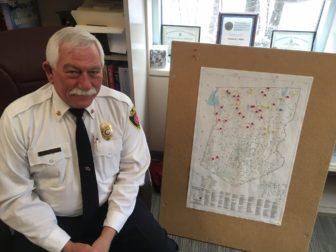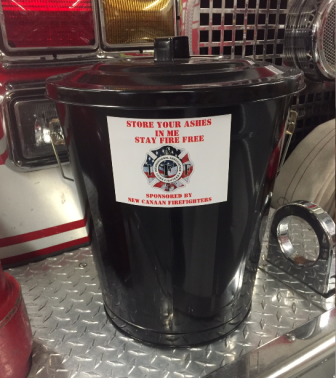Town officials are calling on residents to check whether they’re located on streets that would benefit from a “dry hydrant,” following a garage fire in eastern New Canaan where the main house would have been jeopardized were the apparatus not installed.

Fire Marshal Fred Baker with a map plotting existing and hopeful ‘dry hydrant’ locations. Credit: Michael Dinan
In the end, firefighters were able to control the Dec. 30 Cheese Spring Road blaze with tankers from the New Canaan Fire Department and surrounding towns.
“But God forbid that fire had spread beyond the garage to the main body of the house,” Fire Marshal Fred Baker said. “Then we really would have needed a lot more water.”
And it was available (through about 3,000 feet of large-diameter hose) because a nearby Cheese Spring Road property had a dry hydrant—a pipe that typically runs from a source such as a lake or pond onto dry land and allows firefighters to pump out water.
“The bottom line is, I don’t care how many firefighters you have or how many fire trucks you have—if you don’t have water, you are in a lot of trouble,” Baker told NewCanaanite.com.
Here’s a map plotting roads where Baker and the fire department are seeking dry hydrants (they are upper Valley Road, Laurel Road, Dan’s Highway, Lost District, upper Ponus Ridge, West Road, West Hills Road and Carter Street):
New Canaan now has about 20 dry hydrants scattered throughout town, as well as a handful of cisterns buried underground. Though the first choice in fighting any fire is a pressurized municipal hydrant, officials are constantly looking out for new places where they could go, and often receive referrals from Inland Wetlands Director Kathleen Holland, Baker said.
New Canaan’s zoning regulations also require that following a subdivision, a property must have a water supply available if there is no municipally hydrant to serve it, Baker said.

This is what a proper fireplace ash disposal bucket looks like.
Elevation is a major factor in deciding whether a water source is right for a dry hydrant, as fire trucks can only effectively lift water about 15 feet vertically, Baker said. The department gets about $10,000 per year for water supply costs, which can go toward dry hydrant installation, he said.
“Distance is not the issue—it’s vertical lift,” Baker said.
Anyone who has a question about whether a dry hydrant is appropriate for his or her property should contact the fire marshal’s office at 203-594-3030.
A dry hydrant may have helped firefighters save a house on Frogtown Road a few years ago that burned down because the tankers on scene ran out of water.
The recent fire on Cheese Spring Road was ignited by improperly disposed fireplace ashes—see Baker’s tips on how to do this correctly. A fire in eastern New Canaan one year ago started for the same reason.
